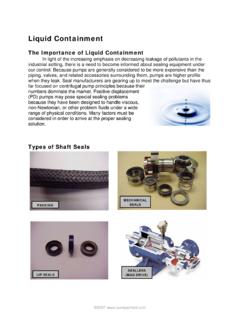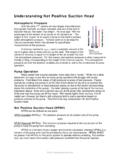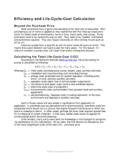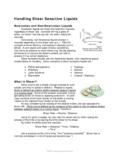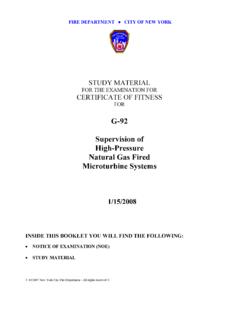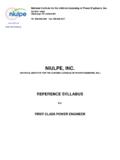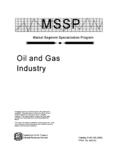Transcription of Pumping Fuel and Fuel Oil
1 Pumping Fuel & Fuel Oil Fuels & Rotary Pumps Though the handling of fuel oil is not necessarily "challenging," the reliable handling of fuel oils is critical for heating and transportation systems. Rotary pumps are an excellent means of loading/unloading, transfer, and circulating fuels. Some examples include: Diesel Fuel (#2 Fuel Oil) Heavy Oils (#5 & #6 Fuel Oils) Crude Oil Gasoline Kerosene (#1 Fuel Oil) Jet Fuel (JP4 & JP5) LP Gas As the following table shows, application details also vary widely. Capacities GPM (0,02 m3/hr) to 1,000+ GPM (230+ m3/hr) Pressures 25 PSI ( BAR) to 250 PSI ( BAR) Viscosities 30 SSU (1 cSt) to 7,500 SSU (1,650 cSt) Temperatures Ambient Outdoor to 250 F (120 C) These variances from application to application result in a wide range of pump constructions and drives.
2 Despite this variance, there are some common guidelines to follow to insure smooth operation and long pump life. Do s & Don ts Slower speeds, lower pressures, and materials designed for the anticipated temperature will pay off in longer trouble-free service, even if oil properties vary from those originally anticipated. Additionally, be sure Install the pump as close as possible to the supply tank. Leave working space around the Pumping unit. Use large, short, and straight suction piping. "Short and fat" pipes are excellent. Install a strainer in the suction line. Double-check alignment after the unit is mounted and the piping is hooked up.
3 Provide overpressure protection for the discharge side of the pump, either in-line or on the pump. Extend service life with preventive maintenance procedures such as periodic lubrication, adjustment of end clearance, and examination of internal parts. Obtain, read, and keep the maintenance instructions furnished with your pump, drive, and other system equipment. 2007 Conversely, DO Run a pump at faster than approved speeds. Run a pump at higher than approved pressures. Run a pump at higher than approved temperatures. Use extra large, extra long suction line with a suction lift.
4 Installing a vacuum gauge and a pressure gauge on or near the pump will also help lengthen service life. Gauges provide a window into what is happening inside the Pumping system. Properly interpreted readings can give clues to the nature of many problems. Long-term readings will show gradual changes taking place within the system. Given the availability of certain fuels at any particular time, many fuel oil systems now accommodate various fuels (#2 through # 6 fuel oil for example). Each fuel oil differs slightly in properties and these differences place unique demands on the system. Be sure to discuss these differences with your pump/system supplier.
5 Handling Crude Oil Crude oil is a naturally occurring liquid found in formations of the earth. It s typically extracted by large reciprocating pumps called pump jacks. The crude oil is then refined into fuels such as gasoline, diesel, kerosene, and other fuel oils. Characteristics such as color and viscosity vary from site to site, but typically fall into the following ranges: Location Viscosity 40-780 SSU (4-170 cSt) at 60 F (15 C) Texas, Oklahoma 34-210 SSU ( cSt) at 100 F (38 C) 75-1,200 SSU (15-250 cSt) at 60 F (15 C) Wyoming, Montana 45-300 SSU ( cSt) at 100 F (38 C) 40-4,800 SSU (4-1,050 cSt) at 60 F (15 C) California 34-700 SSU ( cSt) at 100 F (38 C) 45-200 SSU ( cSt) at 60 F (15 C) Pennsylvania 38-90 SSU ( cSt) at 100 F (38 C) Due to crude oil s high viscosity and wide range of application conditions, rotary pumps are well suited to hcrude oil.
6 Rotary pumps are used for transport, refining, afor high working pressure pipeline sampling applications. While compatible with cast iron, pumps for refinery and pipeline sampling applications are typically steel. Pump construction will depend on the particular oil and applica Many andling nd tion. crude oils contain dirt, sand, and other particulate prior to refining. Often pumps for dirty crude oil are supplied with hardened parts to prevent the particulate from damagingthe pump. 2007 Handling Gasoline and Light Fuel Oils ls have low boiling points and as such, ap andling #2 & #6 Fuel Oil ve six classifications based on their boiling points, is s : oil ranges from to 7 cSt (35 to 50 SSU), but may get even thicker the normal e of led in the range of -20 to 100 F (-30 to 38 C).
7 S with two or more feet of ground cover will normally fuel oil the vacuum reading at the pump should the are #6 fuel oil under the worst conditions ( , highest viscosity and lowest liquid level), liquid presenLight oils such as gasoline, kerosene, and jet fuere the first to be distilled off from crude oil. They are used primarily as fuels. All are fairly easy to handle, but are thin (29-35 SSU / cSt), non-lubricating, and have high vapor pressures. Lifts (when the pump port is above the liquid level in the supply tank) should be kept to 6 feet or less to prevent vaporizing the liquid at the puminlet. Be sure to check the system NPSH to make sure it s adequate.
8 HFuel oils in the United States ha composition, and purpose. #2 and #6 are most commonly used. #2 fuel oilused for truck fuel, heating, and power generation. #6 fuel oil is used for ship fuel (commonly referred to as Bunker C oil), heating (though usually reserved for largerbuildings), and power generation. Typical application conditions for handling fuel oilare as follows: tyViscosi #2 fuel at temperatures below freezing because of congealing wax. #6 fuel oil ranges from 20 to 1,650 cSt (100 to 7,500 SSU) inhandling temperature range, but may vary widely depending on the sourcthe oil, sulfur content, and blend. ormal Handling Temperatures N #2 fuel oil is typically hand #6 fuel oil is typically handled above 100 F (38 C) to reduce the viscosity for ease of handling.
9 Unheated, buried tankstay within a range of 40 to 70 F ( to 21 C), depending on locale and time of year. Lift should be kept to a minimum. For #2 not exceed 15" Hg under the worst conditions. Lifts should be kept to under 10 feet and may be even less depending on suction piping length, fittings, and priming conditions. The vapor pressure of #2 fuel oil is less than PSI ( BAR) at ambient temperatures. If the vacuum at the pump exceeds 15" Hg, entrained air inoil may cause capacity and noise problems. Under vacuum conditions the air will expand and the pump will not deliver its full capacity of oil. While the rotary pumpsself priming, a foot valve is typically recommended to minimize the chance for losing suction.
10 Forposition the pump and select pipe and fitting size to give vacuum readings of 15" Hg or less. The viscosity of #6 Fuel Oil varies from one tank car load to the next. Some tank cars contain "light ends" which affect viscosity and may cause lift problems. For systems to handle #2 or #6 fuel oil, designing a system to handle eitherts problems in sizing the suction lift, fittings, and strainer. 2007 Large rotary pumps are often used in the refining process of fuel oil as well as for transprs used for backup power -Fired Furnaces ial construort and delivery. Upon delivery, smaller rotary pumps take over (usually 30 GPM & smaller), often assembled as a duplex pump system complete with drive equipment, strainers, valves, and controls (figure 1).
